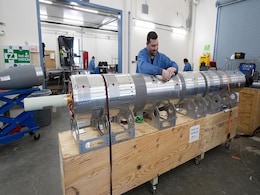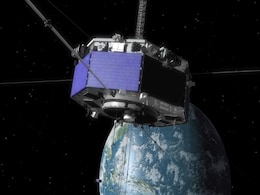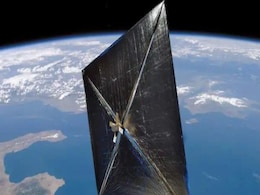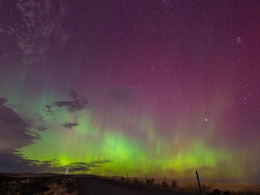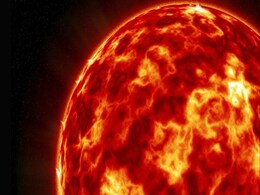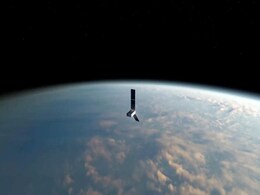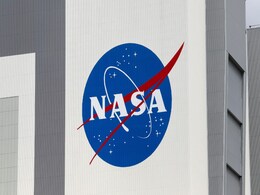Nasa Weather Satellite
- All
- News
-

NASA to Launch Three Rockets in Alaska to Study Auroral Substorms’ Impact
- Saturday March 29, 2025
- Written by Gadgets 360 Staff
NASA is conducting a rocket experiment from Poker Flat Research Range in Alaska. Three rockets will launch within a three-hour window to study how auroral substorms influence the Earth's upper atmosphere. Scientists will observe whether auroras drive vertical convection or if acoustic-buoyancy waves spread their energy over a wider region. Vapour t...
-
 www.gadgets360.com
www.gadgets360.com
-

Partial Solar Eclipse of March 2025: Satellite Images to Show Moon’s Shadow
- Saturday March 29, 2025
- Written by Gadgets 360 Staff
A partial solar eclipse will take place on March 29, 2025, visible across parts of Europe, Africa, and North America. The event will reach its peak in Nunavik, Canada, where 94% of the sun will be covered at sunrise. From space, weather satellites like GOES-16 and Himawari will capture images of the moon’s shadow. The International Space Station ...
-
 www.gadgets360.com
www.gadgets360.com
-

NASA’s EZIE Satellites Begin Mission to Study Auroral Electrojets and Space Weather
- Friday March 21, 2025
- Written by Gadgets 360 Staff
NASA’s Electrojet Zeeman Imaging Explorer (EZIE) mission has been launched aboard a SpaceX Falcon 9 from Vandenberg Space Force Base. The trio of small satellites will map auroral electrojets, powerful currents in Earth’s atmosphere linked to solar storms. Their data will enhance space weather prediction models and help understand planetary mag...
-
 www.gadgets360.com
www.gadgets360.com
-

NASA's MMS Mission Marks 10 Years of Magnetic Reconnection Discoveries
- Monday March 17, 2025
- Written by Gadgets 360 Staff
NASA's Magnetospheric Multiscale (MMS) mission has completed a decade of discoveries, advancing the study of magnetic reconnection—a crucial process in space physics. The four-satellite fleet has enabled over 1,500 research papers, refining theories and revealing unexpected reconnection locations. The mission has also set records for GPS tracking...
-
 www.gadgets360.com
www.gadgets360.com
-

Solar Sail Satellites Could Enhance Space Weather Forecasting and Alerts
- Tuesday February 18, 2025
- Written by Gadgets 360 Staff
Solar sail satellites, harnessing sunlight for propulsion, are being developed to improve space weather forecasting. NOAA and NASA’s Solar Cruiser project aims to extend geomagnetic storm alert times by 50%, reducing risks to power grids, GPS, and air traffic. The new spacecraft, expected to launch in 2029, will move beyond traditional observatio...
-
 www.gadgets360.com
www.gadgets360.com
-

May 2024 Solar Storm Triggers Unusual Radiation Belts, Raising Space Safety Concerns
- Wednesday February 12, 2025
- Written by Gadgets 360 Staff
A significant solar storm in May 2024 led to the creation of two temporary radiation belts, detected by the CIRBE satellite in June. One belt contained high-energy electrons, while the other was rich in protons, a rare occurrence. While the electron belt dissipated in three months, the proton-dominated belt remains, potentially affecting space miss...
-
 www.gadgets360.com
www.gadgets360.com
-

NASA’s PUNCH Mission Set to Track the Sun’s Corona and Solar Wind in 3D
- Friday February 7, 2025
- Written by Gadgets 360 Staff
NASA’s PUNCH mission, set for launch on Feb 27, will deploy four satellites to study the transition between the sun’s corona and the solar wind. The mission aims to improve understanding of space weather by capturing 3D images, helping predict solar storms with greater accuracy. The data will also complement NASA’s Parker Solar Probe, offerin...
-
 www.gadgets360.com
www.gadgets360.com
-

NASA's LEXI Mission Will Explore Earth’s Magnetic Shield from the Moon
- Monday January 13, 2025
- Written by Gadgets 360 Staff
NASA is preparing for the launch of the Lunar Environment Heliospheric X-ray Imager (LEXI) aboard Firefly Aerospace's Blue Ghost lander, scheduled for January 15. The mission will observe Earth’s magnetosphere, capturing X-ray images that reveal how the planet's magnetic shield reacts to solar wind. This project could improve predictions of geoma...
-
 www.gadgets360.com
www.gadgets360.com
-

NASA's Twin Mini Satellites Captures Far-Infrared Radiation from Polar Regions
- Thursday December 5, 2024
- Written by Gadgets 360 Staff
NASA’s PREFIRE mission, launched in 2024, is utilizing CubeSats to capture groundbreaking data on far-infrared radiation emitted from polar regions. These measurements, which track heat escaping from the Arctic and Antarctic, provide critical insights into Earth’s energy balance, a key component in understanding climate change. Despite encounte...
-
 www.gadgets360.com
www.gadgets360.com
-

NASA Disasters Programme Uses Artificial Intelligence to Help Aid Response Efforts
- Wednesday November 27, 2024
- Written by Gadgets 360 Staff
NASA is leveraging artificial intelligence and open science to enhance disaster preparedness, response, and recovery efforts. During events like Hurricane Ida, NASA provided actionable data on soil moisture, flood detection, and power outages through its Disasters Mapping Portal. AI-driven tools, like blue tarp detection for damaged roofs, are aidi...
-
 www.gadgets360.com
www.gadgets360.com
-

NASA Confirms Solar Maximum as Sun Reaches Peak of Its 11-Year Cycle with Heightened Activity
- Friday October 18, 2024
- Written by Gadgets 360 Staff
NASA and NOAA report that the Sun has reached its most active phase in the 11-year solar cycle, known as solar maximum. This period increases solar storms, affecting satellites, astronauts, and Earth's communication and power systems. While the exact peak won’t be confirmed for months, solar activity is expected to remain high for the next year.
-
 www.gadgets360.com
www.gadgets360.com
-

NASA Test Payload Launches Into Space Onboard US Satellite for Improved Weather Forecasting
- Thursday November 10, 2022
- Associated Press
A United Launch Alliance Atlas V rocket carrying the Joint Polar Satellite System-2 satellite and the NASA test payload lifted off on Thursday from California. JPSS-2 was placed into an orbit that circles the Earth from pole to pole, joining previously launched satellites in a system designed to improve weather forecasting and climate monitoring.
-
 www.gadgets360.com
www.gadgets360.com
-

NASA's First Set of Small Satellites for SunRISE Mission Ready to Detect, Track Hazardous Space Weather Events
- Friday August 12, 2022
- Edited by Gadgets 360 Newsdesk
The first of the small satellites to be used in NASA's SunRISE, or Sun Radio Interferometer Space Experiment, have been completed at Utah State University Space Dynamics Laboratory (SDL). The SDL has been contracted by the American space agency to build, test, and commission all six satellites for the mission to detect and track hazardous explosiv...
-
 www.gadgets360.com
www.gadgets360.com
-

NASA, Astra to Send Another Set of Satellites in Orbit After Failure of Previous Weather Mission
- Monday June 13, 2022
- Reuters
NASA, along with Astra, will send another tiny storm-monitoring satellites to orbit as the companies lost their previous mission after engine failure. The earlier test had a rocket carrying two MIT-designed small satellites to measure moisture and precipitation in tropical storm systems.
-
 www.gadgets360.com
www.gadgets360.com
-

GOES-T: NOAA's Latest Weather and Fire-Tracking Satellite Launched to Orbit
- Wednesday March 2, 2022
- Reuters
The GOES-T spacecraft is the third in the latest series of advanced geostationary satellites, credited with revolutionising real-time weather forecasting, environmental monitoring, and hazard detections from space.
-
 www.gadgets360.com
www.gadgets360.com
-

NASA to Launch Three Rockets in Alaska to Study Auroral Substorms’ Impact
- Saturday March 29, 2025
- Written by Gadgets 360 Staff
NASA is conducting a rocket experiment from Poker Flat Research Range in Alaska. Three rockets will launch within a three-hour window to study how auroral substorms influence the Earth's upper atmosphere. Scientists will observe whether auroras drive vertical convection or if acoustic-buoyancy waves spread their energy over a wider region. Vapour t...
-
 www.gadgets360.com
www.gadgets360.com
-

Partial Solar Eclipse of March 2025: Satellite Images to Show Moon’s Shadow
- Saturday March 29, 2025
- Written by Gadgets 360 Staff
A partial solar eclipse will take place on March 29, 2025, visible across parts of Europe, Africa, and North America. The event will reach its peak in Nunavik, Canada, where 94% of the sun will be covered at sunrise. From space, weather satellites like GOES-16 and Himawari will capture images of the moon’s shadow. The International Space Station ...
-
 www.gadgets360.com
www.gadgets360.com
-

NASA’s EZIE Satellites Begin Mission to Study Auroral Electrojets and Space Weather
- Friday March 21, 2025
- Written by Gadgets 360 Staff
NASA’s Electrojet Zeeman Imaging Explorer (EZIE) mission has been launched aboard a SpaceX Falcon 9 from Vandenberg Space Force Base. The trio of small satellites will map auroral electrojets, powerful currents in Earth’s atmosphere linked to solar storms. Their data will enhance space weather prediction models and help understand planetary mag...
-
 www.gadgets360.com
www.gadgets360.com
-

NASA's MMS Mission Marks 10 Years of Magnetic Reconnection Discoveries
- Monday March 17, 2025
- Written by Gadgets 360 Staff
NASA's Magnetospheric Multiscale (MMS) mission has completed a decade of discoveries, advancing the study of magnetic reconnection—a crucial process in space physics. The four-satellite fleet has enabled over 1,500 research papers, refining theories and revealing unexpected reconnection locations. The mission has also set records for GPS tracking...
-
 www.gadgets360.com
www.gadgets360.com
-

Solar Sail Satellites Could Enhance Space Weather Forecasting and Alerts
- Tuesday February 18, 2025
- Written by Gadgets 360 Staff
Solar sail satellites, harnessing sunlight for propulsion, are being developed to improve space weather forecasting. NOAA and NASA’s Solar Cruiser project aims to extend geomagnetic storm alert times by 50%, reducing risks to power grids, GPS, and air traffic. The new spacecraft, expected to launch in 2029, will move beyond traditional observatio...
-
 www.gadgets360.com
www.gadgets360.com
-

May 2024 Solar Storm Triggers Unusual Radiation Belts, Raising Space Safety Concerns
- Wednesday February 12, 2025
- Written by Gadgets 360 Staff
A significant solar storm in May 2024 led to the creation of two temporary radiation belts, detected by the CIRBE satellite in June. One belt contained high-energy electrons, while the other was rich in protons, a rare occurrence. While the electron belt dissipated in three months, the proton-dominated belt remains, potentially affecting space miss...
-
 www.gadgets360.com
www.gadgets360.com
-

NASA’s PUNCH Mission Set to Track the Sun’s Corona and Solar Wind in 3D
- Friday February 7, 2025
- Written by Gadgets 360 Staff
NASA’s PUNCH mission, set for launch on Feb 27, will deploy four satellites to study the transition between the sun’s corona and the solar wind. The mission aims to improve understanding of space weather by capturing 3D images, helping predict solar storms with greater accuracy. The data will also complement NASA’s Parker Solar Probe, offerin...
-
 www.gadgets360.com
www.gadgets360.com
-

NASA's LEXI Mission Will Explore Earth’s Magnetic Shield from the Moon
- Monday January 13, 2025
- Written by Gadgets 360 Staff
NASA is preparing for the launch of the Lunar Environment Heliospheric X-ray Imager (LEXI) aboard Firefly Aerospace's Blue Ghost lander, scheduled for January 15. The mission will observe Earth’s magnetosphere, capturing X-ray images that reveal how the planet's magnetic shield reacts to solar wind. This project could improve predictions of geoma...
-
 www.gadgets360.com
www.gadgets360.com
-

NASA's Twin Mini Satellites Captures Far-Infrared Radiation from Polar Regions
- Thursday December 5, 2024
- Written by Gadgets 360 Staff
NASA’s PREFIRE mission, launched in 2024, is utilizing CubeSats to capture groundbreaking data on far-infrared radiation emitted from polar regions. These measurements, which track heat escaping from the Arctic and Antarctic, provide critical insights into Earth’s energy balance, a key component in understanding climate change. Despite encounte...
-
 www.gadgets360.com
www.gadgets360.com
-

NASA Disasters Programme Uses Artificial Intelligence to Help Aid Response Efforts
- Wednesday November 27, 2024
- Written by Gadgets 360 Staff
NASA is leveraging artificial intelligence and open science to enhance disaster preparedness, response, and recovery efforts. During events like Hurricane Ida, NASA provided actionable data on soil moisture, flood detection, and power outages through its Disasters Mapping Portal. AI-driven tools, like blue tarp detection for damaged roofs, are aidi...
-
 www.gadgets360.com
www.gadgets360.com
-

NASA Confirms Solar Maximum as Sun Reaches Peak of Its 11-Year Cycle with Heightened Activity
- Friday October 18, 2024
- Written by Gadgets 360 Staff
NASA and NOAA report that the Sun has reached its most active phase in the 11-year solar cycle, known as solar maximum. This period increases solar storms, affecting satellites, astronauts, and Earth's communication and power systems. While the exact peak won’t be confirmed for months, solar activity is expected to remain high for the next year.
-
 www.gadgets360.com
www.gadgets360.com
-

NASA Test Payload Launches Into Space Onboard US Satellite for Improved Weather Forecasting
- Thursday November 10, 2022
- Associated Press
A United Launch Alliance Atlas V rocket carrying the Joint Polar Satellite System-2 satellite and the NASA test payload lifted off on Thursday from California. JPSS-2 was placed into an orbit that circles the Earth from pole to pole, joining previously launched satellites in a system designed to improve weather forecasting and climate monitoring.
-
 www.gadgets360.com
www.gadgets360.com
-

NASA's First Set of Small Satellites for SunRISE Mission Ready to Detect, Track Hazardous Space Weather Events
- Friday August 12, 2022
- Edited by Gadgets 360 Newsdesk
The first of the small satellites to be used in NASA's SunRISE, or Sun Radio Interferometer Space Experiment, have been completed at Utah State University Space Dynamics Laboratory (SDL). The SDL has been contracted by the American space agency to build, test, and commission all six satellites for the mission to detect and track hazardous explosiv...
-
 www.gadgets360.com
www.gadgets360.com
-

NASA, Astra to Send Another Set of Satellites in Orbit After Failure of Previous Weather Mission
- Monday June 13, 2022
- Reuters
NASA, along with Astra, will send another tiny storm-monitoring satellites to orbit as the companies lost their previous mission after engine failure. The earlier test had a rocket carrying two MIT-designed small satellites to measure moisture and precipitation in tropical storm systems.
-
 www.gadgets360.com
www.gadgets360.com
-

GOES-T: NOAA's Latest Weather and Fire-Tracking Satellite Launched to Orbit
- Wednesday March 2, 2022
- Reuters
The GOES-T spacecraft is the third in the latest series of advanced geostationary satellites, credited with revolutionising real-time weather forecasting, environmental monitoring, and hazard detections from space.
-
 www.gadgets360.com
www.gadgets360.com

